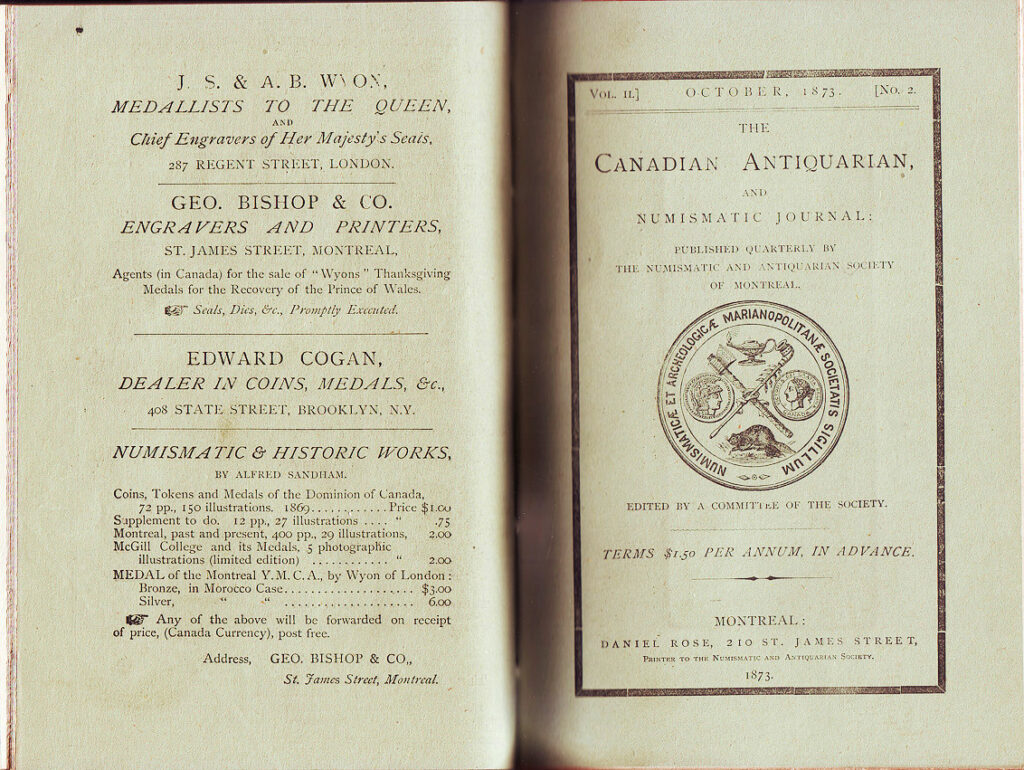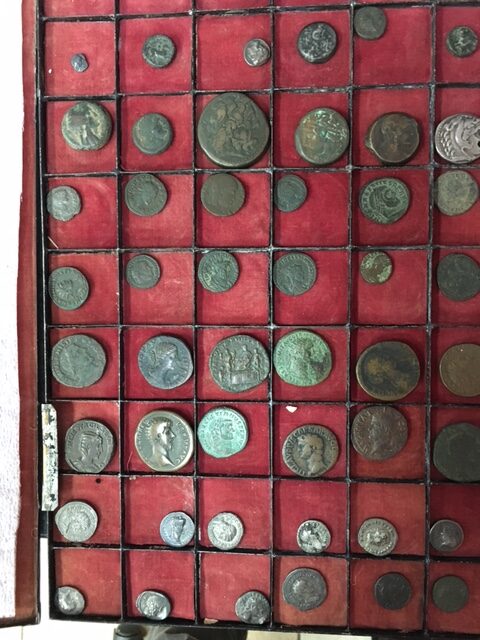When Stanley Clark Bagg’s name appeared in a Montreal city directory in 1866, he was not listed as a “gentleman,” as one might expect. Instead, he gave his occupation as President of the Numismatic and Antiquarian Society of Montreal, a voluntary position related to his hobby.1
Stanley Clark Bagg (1820-1873), or SCB, made his living renting or selling the real estate properties he had inherited from his grandfather, but what he really enjoyed doing was collecting and studying old coins.
He explained his interest in numismatics (the study of coins) in an article he wrote for the Society: “In coins and medals, more than in any other monuments, the past is preserved and its heroes and great events are kept memorable, forms of worship, manners and customs of nations; titles of kings and emperors may thus be determined; — in fact, coins have been frequently of the greatest service, by illustrating doubtful points of history, and even by bringing to light circumstances and events unknown to us before.”2
He gave the example of the Roman Empire: while most of the statues, arches and palaces the Romans built have crumbled to dust, “paltry coins remain monuments of the might of the age; they represent, and record, fresh as the day they were coined, such great historical facts in their inscriptions as Victoriae Brittanicae and Judea Captae.”3

A small group of English-speaking and French-speaking numismatic enthusiasts, including SCB, started getting together around 1860. When they founded the 20-member Numismatic Society of Montreal on Dec. 8 1862, it became the first numismatic society in Canada and the fifth in North America. Adelard J. Boucher was the society’s first president and SCB was founding vice-president.
The society’s name changed in 1866 to the Numismatic and Antiquarian Society of Montreal. At that time, SCB was the organization’s president.4 He also served as an editor of the society’s quarterly journal. In 1863, SCB read the first paper before the Montreal society, the article entitled “Notes on Coins.” His second presentation, given later that year, was “Coins & medals as aids to the study and verification of holy writ.” His presentations were published in the society’s journal. In order to keep up with the latest discoveries about coins, archaeology and science, SCB was a member of several organizations, including numismatic societies in London and in Philadelphia. He was also a corresponding member of the State Historical Society of Wisconsin and a life member of the British Association for the Advancement of Science and the Natural History Society of Montreal.5

No one knows what coins he had in his own collection, but he probably had some special ones. In his will, he left his collection to daughter Mary Heloise Bagg, who later married Robert Lindsay, but I have been unable to find out what happened to it. Some individual coins may still be in the family, or perhaps everything was sold. In 2016, a coin-carrying case that SCB had owned, as well as an inventory and about 40 coins and medals, came on the market and at that time I corresponded with the dealer, who sent me some photos. Coin expert Ted Banning suggests that SCB’s most important contribution to the field was not as a collector, nor even as a writer, but as one of the founders of the Numismatic Society.6 Twenty years after SCB’s death, the society played an important role in saving one of Montreal’s most important heritage buildings, the Chateau Ramezay. The Chateau Ramezay was built in 1705 by Claude de Ramezay, a Governor of Montreal in colonial New France. Over the years the building had various owners and uses, including the offices of a fur trading company and the headquarters of invading American forces in 1775-1776. When the government decided to sell the building in 1893, the Numismatic and Antiquarian Society of Montreal rallied public opinion to save it from demolition. The City of Montreal acquired the building and rented it to the society, which converted it into a museum, open to the public. In 1929, the city ceded the building to the society. Today it remains a museum and a UNESCO-recognized historic site.7
Notes and Sources:
- The listing reads, “Stanley Clark Bagg, JP, President of Numismatic and Antiquarian Society, Fairmount Villa, 583 Sherbrooke Street.” Mackay’s Montreal Directory, 1866; p. 76, entry for Stanley Clark Bagg; digital image, Ancestry.ca, Canada, City and Area Directories, 1819-1906, (database on-line, accessed March 17, 2020.)
- Stanley C. Bagg, “Notes on Coins,” The Canadian Antiquarian and Numismatic Journal, p 4, Montreal: The Numismatic and Antiquarian Society of Montreal, October, 1873. https://babel.hathitrust.org/cgi/pt?id=aeu.ark:/13960/t77s8v32h&view=1up&seq=10(accessed March 19, 2020)
- Ibid p. 8., https://babel.hathitrust.org/cgi/pt?id=aeu.ark:/13960/t77s8v32h&view=1up&seq=15(accessed March 19, 2020)
- Warren Baker, “The First Twelve Years: Canadian Numismatic Publishing 1863-1875, an Annotated Bibliography,” Montreal, 1989.
- “In Memoriam Stanley Clark Bagg, Esq., J.P. F.N.S.” The Canadian Antiquarian and Numismatic Journal, p 73, Montreal: The Numismatic and Antiquarian Society of Montreal, October, 1873. https://books.google.ca/books?id=aX83AQAAMAAJ&pg=PA73&lpg=PA73&dq=In+Memoriam+Stanley+Clark+Bagg&source=bl&ots=GIMssMetqS&sig=ACfU3U2ygp033V5ub7hQjtxWrbnz0HcumQ&hl=en&sa=X&ved=2ahUKEwjZ2JaC7aboAhUNbs0KHTwYDo4Q6AEwEXoECAoQAQ#v=onepage&q=In%20Memoriam%20Stanley%20Clark%20Bagg&f=false (accessed March 19, 2020)
- Ted Banning, “Bagg helped bring social numismatics to Montreal,” Canadian Coin News, March 19, 2012.
- See https://www.chateauramezay.qc.ca/en/


